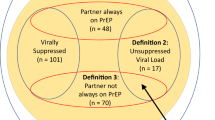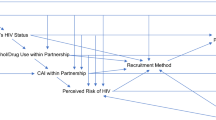Abstract
HIV risk perception may influence the use of HIV prevention interventions. Using data from HIV-negative adults enrolled in a study of pre-exposure prophylaxis (PrEP) and antiretroviral therapy for HIV-serodiscordant couples in Kenya and Uganda, we examined associations between: (1) condom use and risk perception and (2) risk perception and PrEP adherence. Two-thirds of HIV-negative partners reported condomless sex with their HIV-positive partner or another partner in the month prior to study enrollment. Compared to those who reported no condomless sex, participants who reported condomless sex during the month prior to study visit had fivefold higher odds of reporting “high risk” vs “no risk” perception (36.3 versus 10.9%: aOR 4.9, 95% CI 3.4–6.9). Reporting condomless sex in the most recent sex act was associated with increased odds of perceiving some HIV risk (aOR for high risk = 7.3, 95% CI 4.9–10.8; aOR for moderate risk = 4.8, 95% CI 3.5–6.7; aOR for low risk = 3.5, 95% CI 2.7–4.6). We found no significant association between risk perception and PrEP adherence. Sexual behavior aligned with perceived HIV risk, which can facilitate an HIV-negative individual’s decisions about PrEP use.


Similar content being viewed by others
Data Availability
Data are available upon request to the authors’ research center by emailing icrc@uw.edu.
References
Warren EA, Paterson P, Schulz WS, et al. Risk perception and the influence on uptake and use of biomedical prevention interventions for HIV in sub-Saharan Africa: a systematic literature review. PLoS ONE. 2018;13(6):e0198680.
Corneli A, Wang M, Agot K, Ahmed K, Lombaard J, Van Damme L. Perception of HIV risk and adherence to a daily, investigational pill for HIV prevention in FEM-PrEP. J Acquir Immune Defic Syndr. 2014;67(5):555–63.
Do M, Meekers D. Multiple sex partners and perceived risk of HIV infection in Zambia: attitudinal determinants and gender differences. AIDS Care. 2009;21(10):1211–21.
Prata N, Morris L, Mazive E, Vahidnia F, Stehr M. Relationship between HIV risk perception and condom use: evidence from a population-based survey in Mozambique. Int Fam Plan Perspect. 2006;32(4):192–200.
Maughan-Brown B, Venkataramani AS. Accuracy and determinants of perceived HIV risk among young women in South Africa. BMC Public Health. 2017;18(1):42.
Akwara PA, Madise NJ, Hinde A. Perception of risk of HIV/AIDS and sexual behaviour in Kenya. J Biosoc Sci. 2003;35(3):385–411.
Maharaj P, Cleland J. Risk perception and condom use among married or cohabiting couples in KwaZulu-Natal, South Africa. Int Family Plan Perspect. 2005;31(1):24–9.
Nkomazana N, Maharaj P. Perception of risk of HIV infections and sexual behaviour of the sexually active university students in Zimbabwe. SAHARA-J: Journal of Social Aspects of HIV/AIDS. 2014;11(1):42–50.
Omungo PA. Sexual relationships, risk perception and condom use at the University of Nairobi. Int J Health Sci. 2008;1(3):80–7.
Bunnell RE, Nassozi J, Marum E, et al. Living with discordance: knowledge, challenges, and prevention strategies of HIV-discordant couples in Uganda. AIDS Care. 2005;17(8):999–1012.
Ngure K, Mugo N, Celum C, et al. A qualitative study of barriers to consistent condom use among HIV-1 serodiscordant couples in Kenya. AIDS Care. 2012;24(4):509–16.
World Health Organization. WHO expands recommendation on oral pre-exposure prophylaxis of HIV infection (PrEP). Available from: http://www.who.int/hiv/pub/prep/policy-brief-prep-2015/en/. Accessed June 11 2018.
PrEPWatch: an initiative of AIDS vaccine advocacy coalition. Global PrEP Use Landscape as of April 2019. Available from: https://www.prepwatch.org/resource/global-prep-tracker/. Accessed June 21 2019.
Haberer JE. Current concepts for PrEP adherence in the PrEP revolution: from clinical trials to routine practice. Curr Opin HIV AIDS. 2016;11(1):10–7.
Marrazzo JM, Ramjee G, Richardson BA, et al. Tenofovir-based preexposure prophylaxis for HIV infection among African women. N Engl J Med. 2015;372(6):509–18.
Van Damme L, Corneli A, Ahmed K, et al. Preexposure prophylaxis for HIV infection among African women. N Engl J Med. 2012;367(5):411–22.
Baeten JM, Donnell D, Ndase P, et al. Antiretroviral prophylaxis for HIV prevention in heterosexual men and women. N Engl J Med. 2012;367(5):399–410.
Ware NC, Wyatt MA, Haberer JE, et al. What’s love got to do with it? Explaining adherence to oral antiretroviral pre-exposure prophylaxis for HIV-serodiscordant couples. J Acquir Immune Defic Syndr. 2012;59(5):463–8.
Grant RM, Anderson PL, McMahan V, et al. Uptake of pre-exposure prophylaxis, sexual practices, and HIV incidence in men and transgender women who have sex with men: a cohort study. Lancet Infect Dis. 2014;14(9):820–9.
Martin M, Vanichseni S, Suntharasamai P, et al. The impact of adherence to preexposure prophylaxis on the risk of HIV infection among people who inject drugs. AIDS. 2015;29(7):819–24.
Corneli A, Perry B, Agot K, Ahmed K, Malamatsho F, Van Damme L. Facilitators of adherence to the study pill in the FEM-PrEP clinical trial. PLoS ONE. 2015;10(4):e0125458.
Van der Elst EM, Mbogua J, Operario D, et al. High acceptability of HIV pre-exposure prophylaxis but challenges in adherence and use: qualitative insights from a phase I trial of intermittent and daily PrEP in at-risk populations in Kenya. AIDS Behav. 2013;17(6):2162–72.
van der Straten A, Stadler J, Montgomery E, et al. Women’s experiences with oral and vaginal pre-exposure prophylaxis: the VOICE-C qualitative study in Johannesburg, South Africa. PLoS ONE. 2014;9(2):e89118.
Thigpen MC, Kebaabetswe PM, Paxton LA, et al. Antiretroviral preexposure prophylaxis for heterosexual HIV transmission in Botswana. N Engl J Med. 2012;367(5):423–34.
Corneli AL, McKenna K, Headley J, et al. A descriptive analysis of perceptions of HIV risk and worry about acquiring HIV among FEM-PrEP participants who seroconverted in Bondo, Kenya, and Pretoria, South Africa. J Int AIDS Soc. 2014;17(3 Suppl 2):19152.
Haberer JE, Kidoguchi L, Heffron R, et al. Alignment of adherence and risk for HIV acquisition in a demonstration project of pre-exposure prophylaxis among HIV serodiscordant couples in Kenya and Uganda: a prospective analysis of prevention-effective adherence. J Int AIDS Soc. 2017;20(1):21842.
Haberer JE, Ngure K, Muwonge T, et al. Brief report: context matters: PrEP adherence is associated with sexual behavior among HIV serodiscordant couples in East Africa. J Acquir Immune Defic Syndr. 2017;76(5):488–92.
Pyra M, Brown ER, Haberer JE, et al. Patterns of oral PrEP adherence and hiv risk among Eastern African Women in HIV serodiscordant partnerships. AIDS Behav. 2018;22(11):3718–25.
Baeten JM, Heffron R, Kidoguchi L, et al. Integrated delivery of antiretroviral treatment and pre-exposure prophylaxis to HIV-1-serodiscordant couples: a prospective implementation study in Kenya and Uganda. PLoS Med. 2016;13(8):e1002099.
Heffron R, Ngure K, Odoyo J, et al. Pre-exposure prophylaxis for HIV-negative persons with partners living with HIV: uptake, use, and effectiveness in an open-label demonstration project in East Africa [version 1; referees: 2 approved]. Gates Open Res. 2017;1:3.
Irungu EM, Heffron R, Mugo N, et al. Use of a risk scoring tool to identify higher-risk HIV-1 serodiscordant couples for an antiretroviral-based HIV-1 prevention intervention. BMC Infect Dis. 2016;16(1):571.
Psaros C, Haberer JE, Boum Y 2nd, et al. The factor structure and presentation of depression among HIV-positive adults in Uganda. AIDS Behav. 2015;19(1):27–33.
Cherpitel CJ, Ye Y, Bond J, et al. Cross-national performance of the RAPS4/RAPS4-QF for tolerance and heavy drinking: data from 13 countries. J Stud Alcohol. 2005;66(3):428–32.
Broadhead WE, Gehlbach SH, de Gruy FV, Kaplan BH. The Duke-UNC Functional social support questionnaire. Measurement of social support in family medicine patients. Med Care. 1988;26(7):709–23.
Haberer JE, Baeten JM, Campbell J, et al. Adherence to antiretroviral prophylaxis for HIV prevention: a substudy cohort within a clinical trial of serodiscordant couples in East Africa. PLoS Med. 2013;10(9):e1001511.
Heffron R, Ngure K, Odoyo J, et al. Pre-exposure prophylaxis for HIV-negative persons with partners living with HIV: uptake, use, and effectiveness in an open-label demonstration project in East Africa. Gates Open Res. 2017;1:3.
Morton JF, Celum C, Njoroge J, et al. Counseling framework for HIV-serodiscordant couples on the integrated use of antiretroviral therapy and pre-exposure prophylaxis for HIV prevention. J Acquir Immune Defic Syndr. 2017;74 Suppl 1(Suppl 1):S15–22.
Napper LE, Fisher DG, Reynolds GL. Development of the perceived risk of HIV scale. AIDS Behav. 2012;16(4):1075–83.
Bradley H, Tsui A, Hindin M, Kidanu A, Gillespie D. Developing scales to measure perceived HIV risk and vulnerability among Ethiopian women testing for HIV. AIDS Care. 2011;23(8):1043–52.
Vargas SE, Fava JL, Severy L, et al. Psychometric properties and validity of a multi-dimensional risk perception scale developed in the context of a microbicide acceptability study. Arch Sex Behav. 2016;45(2):415–28.
Stringer EM, Sinkala M, Kumwenda R, et al. Personal risk perception, HIV knowledge and risk avoidance behavior, and their relationships to actual HIV serostatus in an urban African obstetric population. J Acquir Immune Defic Syndr. 2004;35(1):60–6.
Tenkorang EY, Rajulton F, Maticka-Tyndale E. Perceived risks of HIV/AIDS and first sexual intercourse among Youth in Cape Town, South Africa. AIDS Behav. 2009;13(2):234–45.
Haberer JE, Bangsberg DR, Baeten JM, et al. Defining success with HIV pre-exposure prophylaxis: a prevention-effective adherence paradigm. AIDS (London, England). 2015;29(11):1277–85.
Rivet Amico K, Bekker LG. Global PrEP roll-out: recommendations for programmatic success. Lancet HIV. 2019;6(2):e137–40.
Acknowledgements
We thank the couples who participated in this study for their motivation and dedication, and the referral partners, community advisory groups, institutions, and communities that supported this work. Partners Demonstration Project Team: Coordinating Center (University of Washington) and collaborating investigators (Harvard Medical School, Johns Hopkins University, Massachusetts General Hospital): Jared Baeten (protocol chair) (University of Washington, Seattle, USA), Connie Celum (protocol co-chair) (University of Washington, Seattle, USA), Renee Heffron (project director) (University of Washington, Seattle, USA), Deborah Donnell (statistician), Ruanne Barnabas, Jessica Haberer (Massachusetts General Hospital, Boston, USA), Harald Haugen, Craig Hendrix, Lara Kidoguchi, Mark Marzinke, Susan Morrison, Jennifer Morton, Norma Ware, Monique Wyatt. Project sites: Kabwohe, Uganda (Kabwohe Clinical Research Centre): Stephen Asiimwe, Edna Tindimwebwa. Kampala, Uganda (Makerere University): Elly Katabira, Nulu Bulya. Kisumu, Kenya (Kenya Medical Research Institute): Elizabeth Bukusi, Josephine Odoyo. Thika, Kenya (Kenya Medical Research Institute, University of Washington): Nelly Rwamba Mugo, Kenneth Ngure. Data management: DF/Net Research
Funding
The Partners Demonstration Project was funded by the Bill & Melinda Gates Foundation (OPP1056051), the National Institute of Mental Health of the US National Institutes of Health (R01MH095507) and the United States Agency for International Development (AID-OAA-A-12-00023). This work is made possible by the generous support of the American people through USAID; the contents are the responsibility of the authors and do not necessarily reflect the views of USAID, NIH, or the United States Government.
Author information
Authors and Affiliations
Consortia
Corresponding author
Ethics declarations
Conflict of interest
Gilead Sciences donated the PrEP medication but had no role in data collection or analysis. The authors disclosed no competing interests.
Ethical Approval
The study protocol was approved by the Human Subjects Division at the University of Washington (#STUDY00001674) and Ethics Review Committees overseeing each study site: Scientific Ethics Review Unit at the Kenya Medical Research Institute (SSC No. 2441), the Ethics Review Committee of Kenyatta National Hospital (P286/05/2012), and the AIDS Research Committee of the Uganda National Council of Science and Technology (ARC 135 and ARC126).
Informed Consent
All participants provided written informed consent.
Additional information
Publisher's Note
Springer Nature remains neutral with regard to jurisdictional claims in published maps and institutional affiliations.
Rights and permissions
About this article
Cite this article
Wanga, V., Baeten, J.M., Bukusi, E.A. et al. Sexual Behavior and Perceived HIV Risk Among HIV-Negative Members of Serodiscordant Couples in East Africa. AIDS Behav 24, 2082–2090 (2020). https://doi.org/10.1007/s10461-019-02773-5
Published:
Issue Date:
DOI: https://doi.org/10.1007/s10461-019-02773-5




